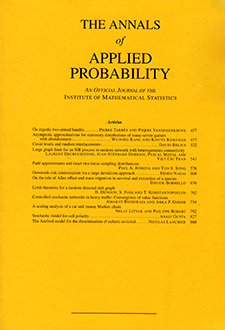Abstract
We investigate the initial behavior of a deterministic model of parasitic infection, appropriate to transmission between homogeneously mixing hosts, where the amount of infection which is transferred from one host to another at a single contact depends on the number of parasites in the infecting host. In this model, $R_0$ can be defined to be the lifetime expected number of offspring of an adult parasite under ideal conditions, but it does not necessarily contain the information needed to separate growth from extinction of infection; nor need the growth rates of parasite numbers and numbers of infected hosts be the same. Similar phenomena are observed if real time is replaced by generation number, and the overlap of generations as time passes need not correspond to that found, for instance, in the supercritical linear birth and death process. The proofs involve martingale methods, applied to a Markov chain associated with the deterministic differential equation system.
Citation
A. D. Barbour. J. A. P. Heesterbeek. C. J. Luchsinger. "Thresholds and initial growth rates in a model of parasitic infection." Ann. Appl. Probab. 6 (4) 1045 - 1074, November 1996. https://doi.org/10.1214/aoap/1035463323
Information





